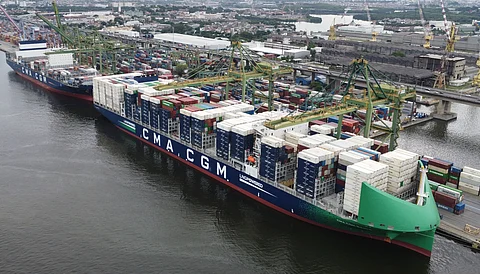
- NEWS
- the EDIT
- COMMENTARY
- BUSINESS
- LIFE
- SHOW
- ACTION
- GLOBAL GOALS
- SNAPS
- DYARYO TIRADA
- MORE

The International Container Terminal Services Inc. (ICTSI) announced that the development of its Luzon International Container Terminal (LICT) is on track and set to serve mammoth vessels upon completion in 2028.
“We’re proud to drive positive change at home by developing a world-class port capable of handling the largest container vessels. This boosts our capacity and helps lead the shift toward a more sustainable shipping industry. Our new Bauan terminal’s ability to accommodate large ships sets it apart and positions us as a leader in efficient and eco-conscious trade,” said Nathan Clarke, ICTSI vice president and head of global engineering for infrastructure and project delivery.
“At the end of the day, if a terminal is unable to handle larger vessels, it’s also unable to fully embrace the new technologies leading to a sustainable future,” the official added in a statement on Wednesday.
The LICT, situated in Bauan, Batangas, is the largest privately funded marine terminal investment in the Philippines and is set to become the country’s second-largest container facility after the ICTSI-run Manila International Container Terminal (MICT).
Further, Clarke said beyond expanding capacity, LICT is expected to support the Philippines’ renewable energy goals, particularly in Southern Luzon.
“With the country shifting toward cleaner energy, the new terminal will meet the growing demand for efficient and eco-friendly marine handling solutions in the region,” he said.
Mega ships handler
A key feature of the Bauan terminal is its ability to handle mega ships, a growing trend in global shipping aimed at increasing efficiency and reducing environmental impact.
These larger vessels can carry significantly more cargo, offering several environmental benefits.
Also, one of the main advantages of mega ships is that they help reduce the number of vessels at sea by transporting more cargo in fewer trips.
This leads to lower fuel consumption, reduced greenhouse gas emissions and less congestion on shipping routes.
For instance, ultra-large container ships carrying over 20,000 containers emit less carbon per container compared to smaller vessels, making them a more sustainable option for global trade.
The company said they are committed to building the LICT terminal with sustainability in mind.
“Every aspect of the terminal’s design and construction will prioritize environmental responsibility. Design and engineering studies are currently underway, with construction set to begin in early 2025. The project will follow strict environmental guidelines to minimize disruption to the local ecosystem,” the statement further stated.
ICTSI’s sustainability track record, seen in its 36-year operation of MICT, serves as the foundation for the Bauan terminal.
Over the years, ICTSI has implemented initiatives like advanced waste and water management systems, circular economy practices, biodiversity conservation programs, and decarbonization efforts to reduce its environmental impact.
Green technology
Mega-ships, like those that will use LICT, are also adopting green technology to further reduce their environmental impact. Many of these ships have energy-efficient engines, streamlined hull designs to reduce drag and use cleaner fuels such as liquefied natural gas. These advancements help lower emissions and comply with international regulations like IMO 2020, which limits sulfur content in marine fuels.
Larger vessels are also more energy efficient. By carrying more containers per trip, they use less fuel per TEU, resulting in reduced emissions.
The Razon-led company also underlined that mega ships help protect marine biodiversity by reducing the number of vessels passing through sensitive areas.
Fewer ships mean less disruption to marine life.
Additionally, larger vessels often follow established shipping routes that minimize environmental impact. Concentrating traffic in a few key ports, rather than many smaller ones, helps reduce overall ecological damage.
Various mega ships are equipped with ballast water management systems to prevent the spread of invasive species, further supporting marine conservation efforts.
As the global shipping industry works to reduce its environmental footprint, mega ships, like those that will call the LICT offer a solution. Their ability to move more cargo with less fuel and fewer resources makes them key to the industry’s sustainability efforts. With green technology, lower fuel consumption, and reduced impact on marine ecosystems, these ships play a crucial role in making the shipping industry eco-friendlier.
